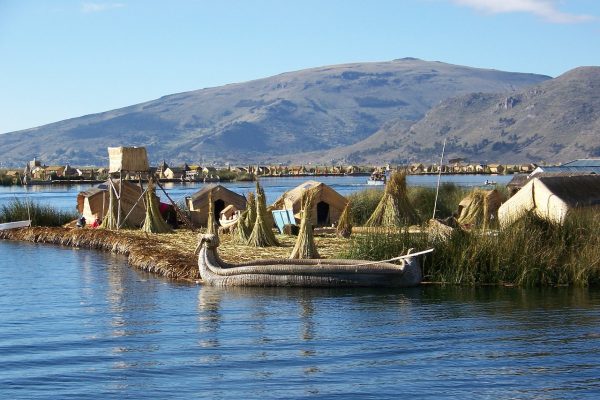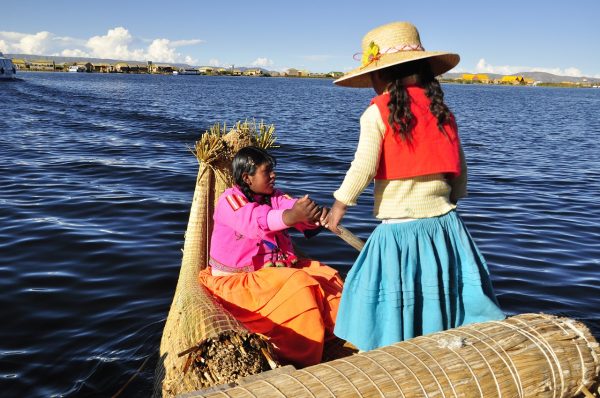Lake Titicaca is a stunning body of water on the border between Peru and Bolivia. It’s the largest lake in South America, and one of the highest navigable lakes in the world, sitting at an elevation of 12,500 feet above sea level.

You may have already known the above, as it’s plastered on tourism campaigns and postcards, but the lake has a number of ancient traditions, cultures, and mysteries which you may not have been aware of.
Here are some facts you probably didn’t know about Lake Titicaca – well worth a visit if you’re planning a trip to Peru!
Sacred to the Incas
Lake Titicaca was considered sacred by the Incas, who revered it as the birthplace of their civilization. According to Inca mythology, the god Viracocha emerged from the waters of the lake and created the sun, moon, and stars. The first Inca ruler, Manco Capac, and his sister Mama Ocllo emerged from the lake’s waters and went on to found the Inca Empire.
The Incas believed that the lake was a sacred place where the spirits of their ancestors resided. They made pilgrimages to the lake to offer gifts and sacrifices to the gods and to seek guidance and blessings for their people. The Incas also believed that the lake had healing powers and that its waters could cure illnesses and protect against evil spirits.
The Inca civilization was known for its advanced knowledge of astronomy, and they believed that Lake Titicaca was a gateway to the stars. They built several observatories around the lake to study the movements of the planets and the stars and to make predictions about the future.
The Incas also developed a sophisticated system of agriculture, and they built terraced fields around the lake to cultivate crops such as maize and quinoa. They believed that the fertility of the land around the lake was due to its sacred nature and the blessings of the gods.
Today, Lake Titicaca remains a sacred place for many indigenous groups in the Andean region. Its cultural and spiritual significance continues to inspire people, and it’s well worth planning a trip from Arequipa to Puno to spend a night with the local communities.

Home to the Uros People
The Uros people are a unique group of indigenous people who live on floating islands in Lake Titicaca. These islands are made entirely out of totora reeds, a type of plant that grows in the lake.
What makes the Uros people special is their way of life, which has remained largely unchanged for hundreds of years. They live in small communities on the floating islands and rely on fishing and weaving to sustain themselves. The Uros people are skilled weavers and create beautiful textiles, such as hats, scarves, and blankets, which they sell to tourists.
Despite facing challenges such as environmental degradation and limited resources, the Uros people have managed to maintain their traditional way of life and preserve their culture. They have a deep connection to the lake and believe that their ancestors emerged from its waters. The Uros people also have a unique language and cultural practices that have been passed down through generations.
Today, the Uros people have opened up their communities to visitors and offer tours of their floating islands. This provides an opportunity for travelers to learn about their unique way of life, interact with the locals, and appreciate the beauty and significance of Lake Titicaca.
Has a Mysterious Underwater Temple
In 2000, a team of divers discovered a mysterious underwater temple at the bottom of Lake Titicaca. The temple is believed to be more than 1,000 years old and was likely built by the Tiwanaku civilization, an ancient culture that thrived in the Andean region between 300 and 1000 AD.
The temple is made up of a series of stone structures, including walls, terraces, and staircases, and is believed to have been a place of worship and ceremony.
Has Unique Marine Life
You don’t exactly think of Lake Titicaca as a wildlife destination, but it’s actually home to a unique variety of marine life, including several species that are found nowhere else in the world.
The most famous of these is the Titicaca water frog, also known as the Telmatobius culeus. This frog is the largest fully aquatic frog in the world, and is unique in that it breathes through its skin rather than its lungs.
This frog however is critically endangered, and conservation efforts are underway to protect it, as it plays an important role in the local ecosystem. One of the main threats is habitat loss and degradation from pollution, mining, agriculture, and other human activities, but another is poaching – the frog is considered a delicacy in local cuisine, and its skin and other body parts are used in traditional medicine.
Sits at the Intersection of Two Major Cultures
Lake Titicaca sits at the intersection of two major cultural regions in South America: the Andes and the Amazon.
The Andes region is known for its high altitudes, rugged terrain, and traditional indigenous cultures, while the Amazon region is known for its lush rainforests, diverse wildlife, and vibrant mix of indigenous and immigrant cultures.
The unique blend of these two cultures is evident in the people, languages, customs, and traditions of the region.
Has Prehistoric Ruins on Its Shores
The shores of Lake Titicaca are home to several prehistoric ruins, including the Chullpas de Sillustani. These towers were built by the Colla people, a pre-Inca civilization that thrived in the region between 1200 and 1450 AD.
The towers were used as funerary monuments and are made of massive stone blocks that were carefully fitted together without the use of mortar.
How many of these facts about Lake Titicaca did you know?

